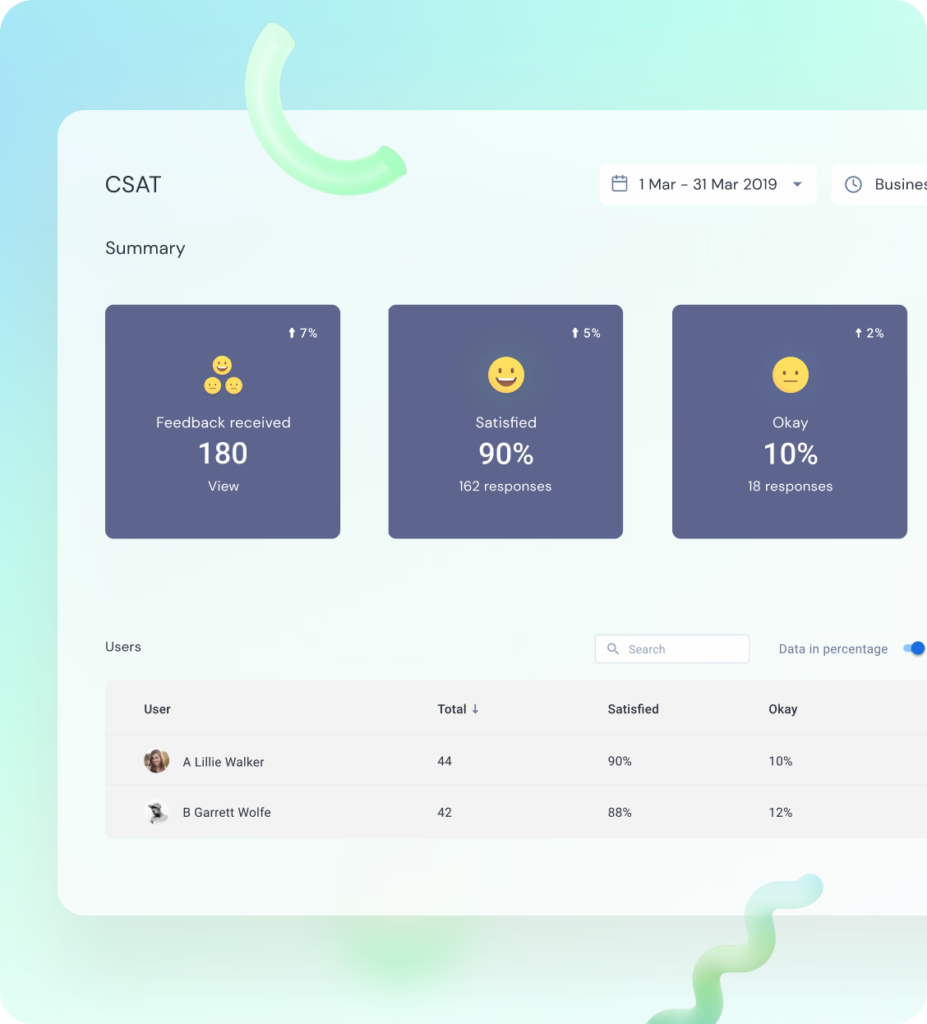How to Create a Customer Feedback Loop to Improve Your CX

Table of contents
Imagine walking into a restaurant and being served a dish you didn’t order. What will you do next? You will return the dish and will certainly be disappointed because this is simply not what you asked for.
Now, think of that dish as a product or service and the customer as the diner. If businesses don’t listen to their customers, they’re essentially serving them something they didn’t ask for. According to a study by PwC, 73% of consumers point to customer experience as a crucial factor in their purchasing decisions.
If you wish to truly serve your customers, you need to know their preferences and turn them into actionable steps. This is where a customer feedback loop comes into play, acting as the bridge between your customers’ needs and your business offerings.
Before we dig for how to implement an effective customer feedback loop that truly works, let’s understand what a customer feedback loop is.
Table of Contents
- What is a Customer Feedback Loop?
- Steps of a Customer Feedback Loop
- Why should you create a customer feedback loop?
What is a Customer Feedback Loop?
A customer feedback loop is a system that captures, analyzes, and implements feedback from customers to refine products, services, or processes. Picture it as a never-ending cycle where customers are like teachers, and businesses are the eager students.
For instance, when Airbnb users expressed concerns about safety, the company introduced features like host verification, making travelers feel more secure. Similarly, Evernote realized that users wanted a better way to clip web articles, leading to the creation of their Web Clipper feature — which grew to be one of Evernote’s most loved features.
Steps of a Customer Feedback Loop
A well-executed customer feedback loop can truly change the game for your product or service. Why? Simply because you know what your customers want, give them what they need and can try to anticipate what they might want in the future.
So, it’s simple: a feedback loop is one where a brand not only collects feedback but actions it/executes it. Here are the steps involved in executing a customer feedback loop that will improve your customer experience:
i. Collection: Gather feedback from various sources.
ii. Analysis: Break down the feedback to uncover actionable insights.
iii. Action: Implement the necessary changes based on feedback.
iv. Communication: Notify customers of the changes made.
v. Review: Monitor the impact of the changes on the customer experience.
Let’s take a look at each of these steps in detail and understand how to execute them all in the best way possible.
1. Collection
Today, the voice of the customer is more pronounced and accessible than ever. The collection phase is about harnessing this vocal energy. By actively seeking feedback, businesses can gain insights directly from the customer’s perspective.
Whether these insights come from direct conversations or online platforms, it’s crucial to have a mechanism to capture them consistently. Furthermore, having a diverse range of collection methods ensures that you’re getting a full spectrum of opinions spanning various demographics and customer personas.
The collection stage in a customer feedback loop can have sub-parts depending on what information you are particularly looking for from your customers.
For instance, Spotify collects feedback from its listeners via its Daily Mix playlists to help users discover music that’s right down their alley:

With a simple feature to like or dislike a track, Spotify gathers feedback on how well they are doing with their suggestions. Similarly, depending on the inputs you are looking for—be it for a feature or your product as a whole, your collection stage will have different types of surveys and questionnaires.
If you are looking to build a customer feedback questionnaire on common use cases, here are some sample questions to get you started.
Here are some tips to ensure your collection stage gathers the right data and is collected seamlessly by your customers:
- Utilize online surveys post-purchase or service experience. If you use a customer service platform, you can seamlessly collect this data from your customers by easily plugging in short surveys in your emails. Tools like SurveyMonkey or Google Forms can also be helpful to conduct your surveys.

- Encourage reviews on platforms relevant to your business. For instance, if you have a business software or service, G2 is a relevant site to encourage your users to drop their reviews. Positive reviews on these sites can also help your prospects to choose your product over your competitors.
- Set up social media listening tools, such as Brandwatch and Awario, to capture mentions of your brand. You can set up alerts on these tools to notify you when your brand is mentioned on social media — giving you a chance to know what customers are saying about your brand online and convert them into actionable insights.
2. Analysis
Simply collecting feedback isn’t enough. The analysis phase acts as a sieve, filtering out the gold nuggets of actionable insights from the gravel of generic comments.
It’s essential to dive deep into the feedback, dissecting every aspect to understand the underlying sentiment. Many customer service platforms also provide visual reports and key metrics to help you analyze responses. Doing so allows businesses to transform raw feedback into a roadmap for improvements.
Regular analysis ensures that emerging trends or new issues are promptly identified, allowing businesses to be proactive in their response. Moreover, a systematic approach to analysis ensures that no crucial insight slips through the cracks.
This analysis is a crucial part of this process that ensures that you are basically interpreting all the customer feedback the right way and have the steps for your next phase clear and ready. For instance, Amazon analyzes product reviews and uses algorithms to identify frequently mentioned terms, highlighting recurring themes to improve their customer service.
Here are some things to keep in mind when you are analyzing the feedback you gathered:
- Use sentiment analysis to gauge the mood of the feedback. Sentiment analysis is a natural language processing (NLP) technique that is used to determine the emotional tone behind a piece of text.
It can be used to analyze customer feedback to gauge the overall sentiment of customers, as well as to identify specific areas where customers are happy or unhappy. Some tools that can help you with this include Google Cloud Natural Language API and Amazon Comprehend. - Once you have analyzed the sentiment of the customer feedback, you should categorize it into themes to identify the most common areas where customers are having positive or negative experiences.
When categorizing the feedback, be sure to use clear and concise categories. For example, you might have categories such as “product features,” “customer service,” and “pricing.”
- Organize regular team meetings to discuss and interpret the feedback. This will help you to identify actionable insights that can be used to improve your products and services.
3. Action
Turning insight into action is where the magic happens. It’s one thing to understand what customers want, but it’s an entirely different challenge to execute these changes effectively. Implementing changes based on feedback is a testament to a company’s commitment to its customers.
However, it’s essential to strike a balance. While it’s tempting to make all changes at once, it’s more practical to prioritize them based on feasibility and impact.
Furthermore, the action phase isn’t just about addressing negative feedback. Positive feedback can spotlight strengths that can be further amplified to deliver an even better customer experience.
While you implement your action phase, here are some pointers to keep in mind:
- Create a priority list of changes to be made based on feasibility and impact. Consider the resources required to implement each change. Then, prioritize changes that will have the biggest impact on customer satisfaction and the bottom line.
- Improving your customer experience is an organization-wide responsibility. Involve different departments in the implementation of changes to ensure a cohesive and effective approach.
Get input from different departments, such as product development, sales, and customer service, to ensure that changes are aligned with the overall business strategy and customer needs. - Identify key metrics to track, such as customer satisfaction scores, customer churn rates, and sales conversion rates. Analyze this data to determine the effectiveness of the changes made and identify areas for further improvement.
4. Communication
After acting on feedback, it’s imperative to close the loop by reaching out to customers.
Informing them not only showcases responsiveness but also makes customers feel valued and heard. Moreover, effective communication can turn even a previously disgruntled customer into a loyal advocate.
However, it’s essential to ensure that communication is clear, concise, and genuine. Avoid corporate jargon and keep the focus on the customer’s role in driving positive change. Here are some more tips to ensure clear communication with your customers in a customer feedback loop:
- Utilize email newsletters or in-app notifications to effectively communicate changes. Email newsletters offer a direct channel for detailed updates, while in-app notifications ensure that active users are immediately aware of new developments.
- Always make it a point to thank customers for their feedback. This simple act of acknowledgment not only conveys appreciation but also fortifies the bond between the business and its customers.
- It’s crucial to maintain transparency in all dealings. If there are instances where certain feedback cannot be implemented, provide a candid explanation. This approach ensures that customers feel both understood and valued, even if their specific suggestions aren’t put into action.
5. Review
The customer feedback loop, by design, is cyclical. The review phase acts as the bridge connecting one cycle to the next. After making changes, it’s essential to assess their impact. Did the modifications lead to a better customer experience? Are there any unintended consequences?
Regular reviews ensure that businesses remain agile, making adjustments as needed. Moreover, continuous feedback solicitation during this phase can validate whether implemented changes resonate with customers. By doing so, businesses maintain a dynamic, evolving relationship with their customers, fostering long-term loyalty.
- To effectively gauge the success of your recent modifications, integrate Key Performance Indicators (KPIs) that align with the changes. Monitoring these metrics provides a quantifiable way to measure the direct impact of adjustments on the customer experience.
- Maintaining an open channel for feedback is essential. Proactively seek out responses specifically about the recent alterations you’ve implemented. This not only keeps the dialogue active but ensures you’re getting direct feedback on the areas you’ve focused on.
- Business is all about improving your processes, so rest on no laurels. Continuously refine and recalibrate based on the fresh feedback and observations you gather. Stay agile, and be ready to make iterative changes that further enhance the customer experience.
A case in point: Whenever Netflix introduces tweaks to their user interface or algorithms, they diligently track viewer behaviors and trends, ensuring that every change translates into an enhanced viewing experience for the users.
Why should you create a customer feedback loop?
A well-oiled customer feedback loop is like your ship’s compass in the currents of customer preferences—-which are swift and ever-changing.
By genuinely listening, dissecting feedback, making the necessary course corrections, and most importantly, circling back to say, “Look, we made these changes thanks to you,” you’re creating advocates who will stick with you and bring in more customers.
Understanding and adapting to customer preferences is an ongoing, iterative journey. Leveraging platforms like Hiver to gather consistent feedback ensures your business stays aligned with your audience’s evolving needs.
If you are a startup looking to create a customer feedback loop, apply for Hiver’s Startup Program and get six months of free access and more benefits to improve your customer experience.

































